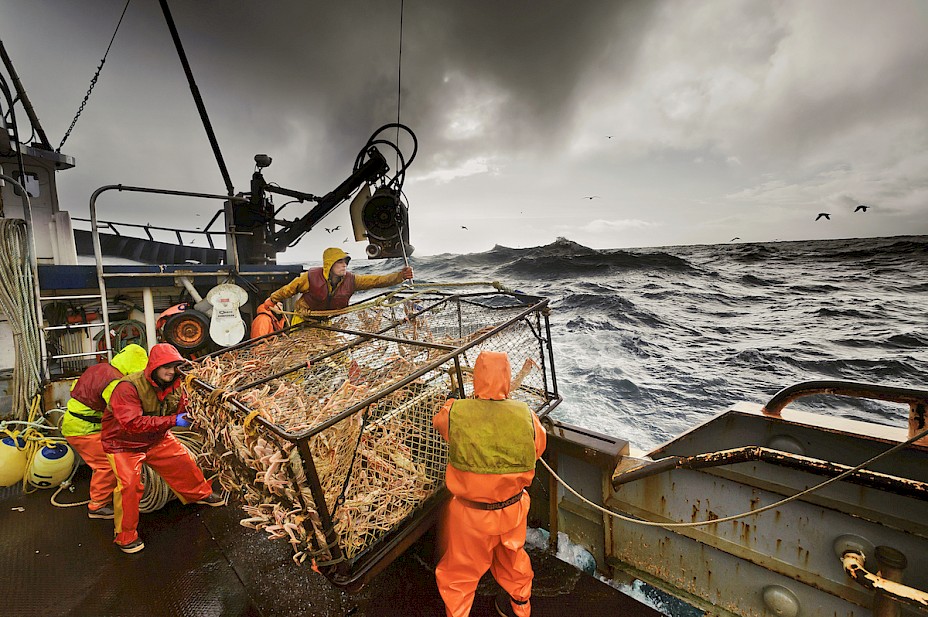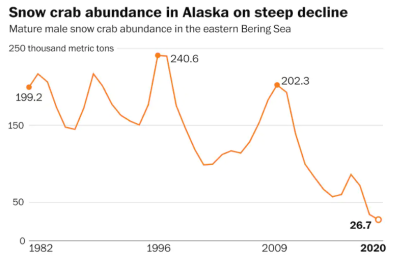Alaskan king and snow crab populations have plummeted

The theories are many. The crabs moved into Russian waters. They are dead because predators got them. They are dead because they ate each other. The crabs scuttled off the continental shelf and scientists just didn’t see them. Alien abduction.
Okay, not that last one. But everyone agrees on one point: The disappearance of Alaska’s snow crabs probably is connected to climate change. Marine biologists and those in the fishing industry fear the precipitous and unexpected crash of this luxury seafood item is a harbinger, a warning about how quickly a fishery can be wiped out in this new, volatile world.
Gabriel Prout and his brothers Sterling and Ashlan were blindsided. Harvests of Alaskan king crab — the bigger, craggier species that was the star of the television show “Deadliest Catch” — have been on a slow decline for over a decade. But in 2018 and 2019, scientists had seemingly great news about Alaska’s snow crabs: Record numbers of juvenile crabs were zooming around the ocean bottom, suggesting a massive haul for subsequent fishing seasons.
 Prout, 32, and his brothers bought out their father’s partner, becoming part owners of the 116-foot Silver Spray. They took out loans and bought $4 million in rights to harvest a huge number of crabs. It was a year that many young commercial fishers in the Bering Sea bought into the fishery, going from deckhands to owners. Everyone was convinced the 2021 snow crab season was going to be huge.
Prout, 32, and his brothers bought out their father’s partner, becoming part owners of the 116-foot Silver Spray. They took out loans and bought $4 million in rights to harvest a huge number of crabs. It was a year that many young commercial fishers in the Bering Sea bought into the fishery, going from deckhands to owners. Everyone was convinced the 2021 snow crab season was going to be huge.
Scientists, despite earlier optimistic signs, found that snow crab stocks were down 90 percent. The season opened and the total allowable harvest went from 45 million pounds to 5.5 million pounds. Commercial fishers couldn’t even catch that quantity.
In October 2021, the Alaska Department of Fish and Game closed the king crab season entirely to harvesting, for the first time since the 1990s.
“It was a struggle,” Prout said. “We were pulling up close to blank pots. We’d be searching several miles of ocean floor and not even pulling up 100 crabs. We were grinding away and barely caught what we were allowed to catch.”
King crabs are massive, up to 20 pounds each, with thick, spiky shells that diners need tools to crack. Snow crabs are between 2 and 4 pounds and have thinner shells that can be cracked with your hands. Snow crabs are the biggest crab industry in Alaska and, while still a splurge (in a normal year around $25 per pound), they tend to be much less expensive than kings. Both have sweet, briny white meat that pulls out in long pieces.
Go to Joe’s Stone Crab in D.C. for an order of those sweet, luxurious crab legs and you’re likely to have palpitations: $199.95 for 1½ pounds of king crab. King crab is served chilled with drawn butter and is cracked tableside. But still, that price tag is startling.
For restaurateurs seeking new sources to make up for Alaska’s shortfall, there’s an additional headache: The U.S. government in March banned imports of Russian fish and seafood products, along with other consumer items such as vodka and diamonds, as part of its expanding sanctions on Russia over its invasion of Ukraine.
At Klaw, a hot new restaurant in Miami, managing partner George Atterbury has worked with Troika Seafood, a Norwegian seafood wholesaler, to bring in live red king crab from Finnmark County, Norway’s northernmost county. They are flown overnight via Norse Atlantic Airways into Fort Lauderdale. Each of the prehistoric-looking animals, which can have a five-foot leg span, is tracked with a QR code.
“We house the live king crab in a separate facility within our restaurant in 2,000-gallon tanks,” Atterbury said. “The costs fluctuate aggressively, but we understand that we can only pass a small percentage to the customer as we are price-sensitive on what is reasonable.”
The collapse of two of three major crab stocks in Alaska — there’s a third, bairdi crab, also called tanner crab, which is doing fine, but is a much smaller industry — is more than a gastronomic inconvenience for the one-percenters. It is the main source of income for many of the 65 communities that make up the Western Alaska Community Development Quota Program, which allocates a portion of the annual fish harvest of certain commercial species directly to coalitions of villages that, because of geographic isolation and diminished access to sources of income, have had limited economic opportunities, says Heather McCarty, a fisheries consultant in Juneau.
The program was established to provide economic and social benefits for residents of western Alaska, alleviating poverty in what often are Indigenous communities.
“I work in the Pribilof Islands for an Aleut community of 450 people, which is heavily invested in the crab quota,” McCarty said. On the island of St. Paul, Trident Seafoods has one of the largest crab processing plants in the world, employing as many as 400 workers during peak snow crab season in February. This February, it was quiet.
“The whole community of St. Paul is run on the fish tax. It’s 85 percent of the revenue of the community,” she said. “They had some [financial] reserves last year, but it’s not going to go well in the future. King crab has been declining for a while, but snow crab had been quite successful and took a nosedive that nobody expected.”
She says what happened with snow crabs is an example of the kind of rapid changes in resource availability that climate change is making commonplace beneath the sea. In some cases, the abrupt changes are apparent when species flourish. “There’s been a record return of sockeye salmon in Bristol Bay,” she said. “It does seem that these rapid changes can have extreme consequences.”
But what happened to those snow crabs?
“We don’t have data to specifically say what happened,” said the National Oceanic and Atmospheric Administration’s Bob Foy, the science and research director of the agency’s Alaska Fisheries Science Center. “What we know is that we had extreme heat wave in 2019, and we had numerous fish and crab stocks moving into areas they hadn’t been historically. The fishery moved its effort toward the northwest.”
But movement alone doesn’t explain it. Crabs are a benthic species, meaning they crawl around on the ocean bottom and are not able to migrate as quickly as many finfish.
“The biomass of crabs up there at St. Lawrence Island [northwest of mainland Alaska in the Bering Sea] didn’t change much. What that suggests is there was a large mortality event or they moved into deeper water beyond our survey or into the Russian shelf,” Foy said, but he sounds skeptical about that last possibility. “The magnitude of biomass could not all have moved without us detecting it. We believe we had a very large mortality event, which points to an extreme event that we have never seen before in the Bering Sea.”
He said the crabs, perhaps because of heightened sensitivity to their ecosystem, are like the canary in a coal mine — for the climate and those who make their living from crabbing.
Crabbers are waiting to hear whether the state’s $200 million snow crab industry will be severely curtailed for the 2022-2023 season, and on Oct. 15, they find out if the king crab season is closed entirely for a second year.
Jamie Goen, the executive director of the Alaska Bering Sea Crabbers trade association, said the crab collapse is affecting blue collar workers and small family businesses the most. For commercial fishers, nothing like farmers’ “crop insurance” is available, and although the U.S. Department of Commerce is directing nearly $132 million to Alaska for fishery disasters, it will take years for money to reach those affected, Goen said. And if reports of crab deaths are greatly exaggerated and the crustaceans have instead permanently migrated northward to colder waters, fishing farther north in the Bering Sea is too dangerous for Alaskan owner-operator vessels, in part because there are no Coast Guard services there to respond to medical emergencies or boat trouble.
The Prout family is diversifying by “tendering” cod and herring, essentially acting as a courier to transport caught fish to the canneries so the commercial fishers can keep fishing. They’re hauling other people’s catch to work off that $4 million loan.
“To recoup a 90 percent loss, there aren’t a lot of options,” Gabriel Prout said via satellite phone from aboard the Silver Spray, en route from Cordova to Kodiak to tender cod. “It’s a bleak time for the industry. A lot of people will sell their vessels or sell their quota to make ends meet. Dad is handling this remarkably well, but he’s always an optimistic person.”
You can return to the main Market News page, or press the Back button on your browser.

